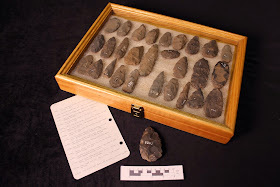Artifact collecting is a favorite activity of many people in
Pennsylvania and one that has been taking place for over a hundred years.
Evidence of early collecting can be seen in the large assemblages of Civil War
artifacts collected immediately following the retreat of troops from the
Gettysburg Battlefield and in the cases of projectile points recovered from
cornfields along the Susquehanna River in the early 1900s. These collections often represent the remains
of previously unknown sites that could provide important information to the
history and prehistory of Pennsylvania.
Case of artifacts from the
Exley Collection (Photo Credit: The State Museum of Pennsylvania, Section of
Archaeology)
Site documentation can range from simply noting locations on
a map to keeping detailed field notes, mapping site boundaries and features,
and taking photographs of important site characteristics. Handheld, mobile
phones and Global Positioning Units (GPS) make finding and mapping site and
artifact locations simple.
Field notes and photos document
a rockshelter site from the Jacob Grimm Collection (Photo Credit: The State
Museum of Pennsylvania, Section of Archaeology)
Example of a PASS form
(Photo Credit: The State Museum of Pennsylvania, Section of Archaeology)
Cataloging the artifacts recovered from sites and recording
their location is also an important part of the process. Designate a letter or
number code to place on each artifact and key it to a list describing the type
of artifact, material, and age if possible. Even if you are not sure how to
identify your artifact properly, keying your finds to a map will allow
researchers to determine spatial patterning at the site.
Artifact logs associated
with the Assmus Collection (Photo Credit: The State Museum of Pennsylvania,
Section of Archaeology)
Artifact inventory and associated
point fragments from the Jacob Grimm Collection (Photo Credit: The State Museum
of Pennsylvania, Section of Archaeology)
So, what happens if you decide you no longer want your
collection or that you would rather share it for the research potential it may
represent? Many people choose to donate their collections to the State Museum,
providing significant research opportunities to future generations. Donations
may be as large as several thousand artifacts or as small as one unique item,
such as the unusual hafted maul recovered in the City of Harrisburg.
Hafted maul from the
Finley Collection (Photo Credit: The State Museum of Pennsylvania, Section of
Archaeology)
A collection is not only the
artifacts you’ve collected, but also the documentation. Documentation includes
notes, maps, and catalogs as well as photos of the field work and the artifacts
if you have them. A signed Deed-of-Gift form indicating your intentions of
donating a collection to the museum must accompany the artifacts.
A new exhibit in the Archaeology
Gallery on the second floor of the State Museum will showcase much of the
information included in this blog. Please stop in soon to see it! More
information on recording sites, cataloging artifacts, and donating collections
can be found at http://www.portal.state.pa.us/portal/server.pt/community/recording_resources/3683.














